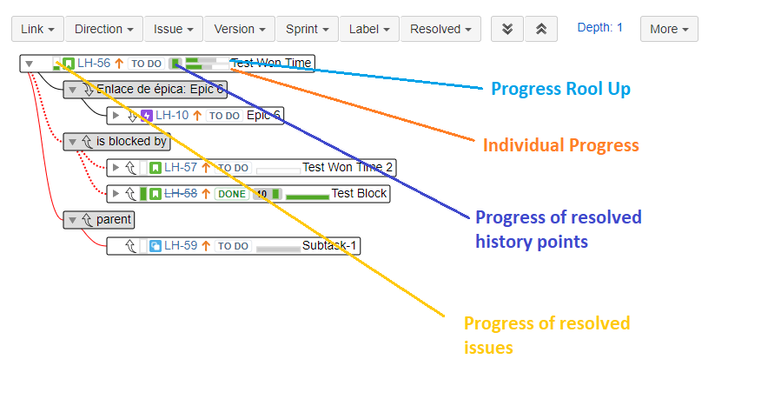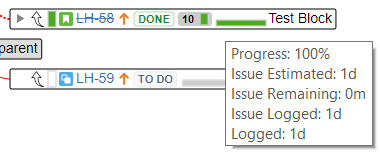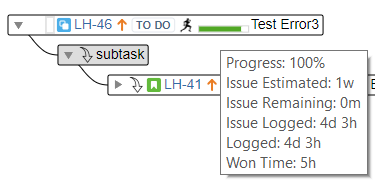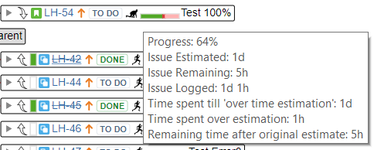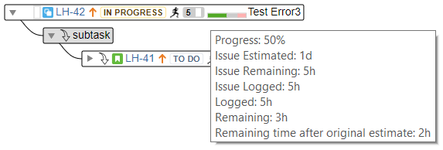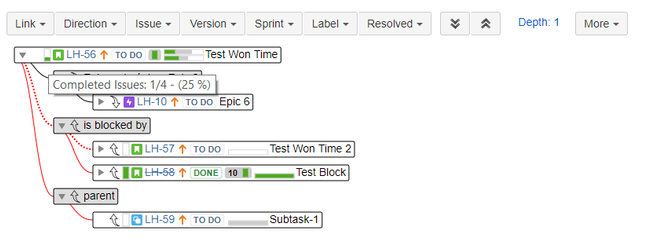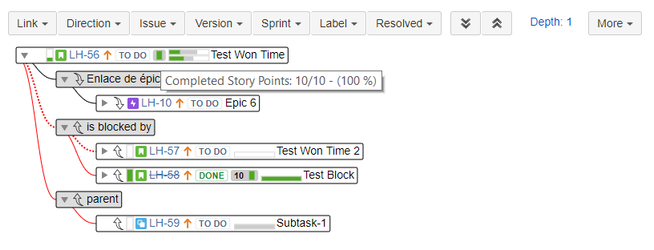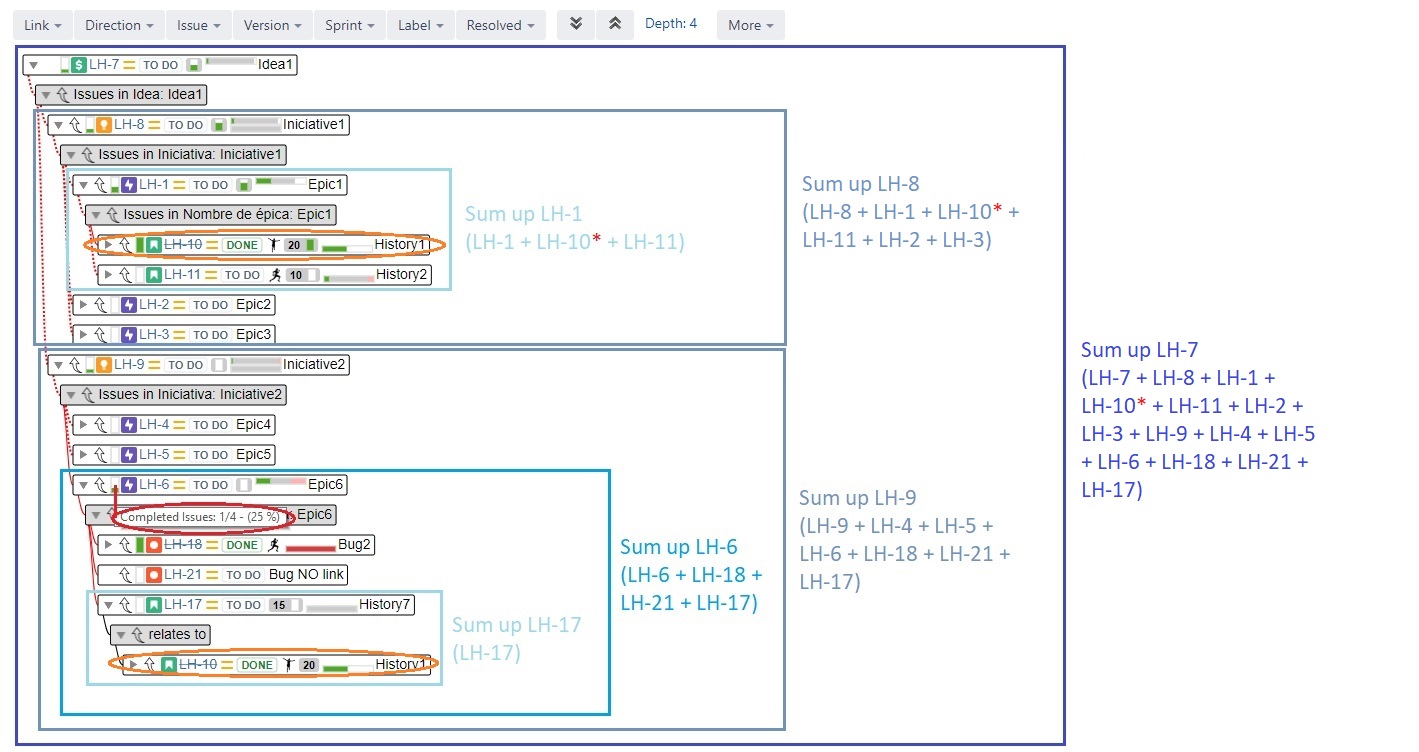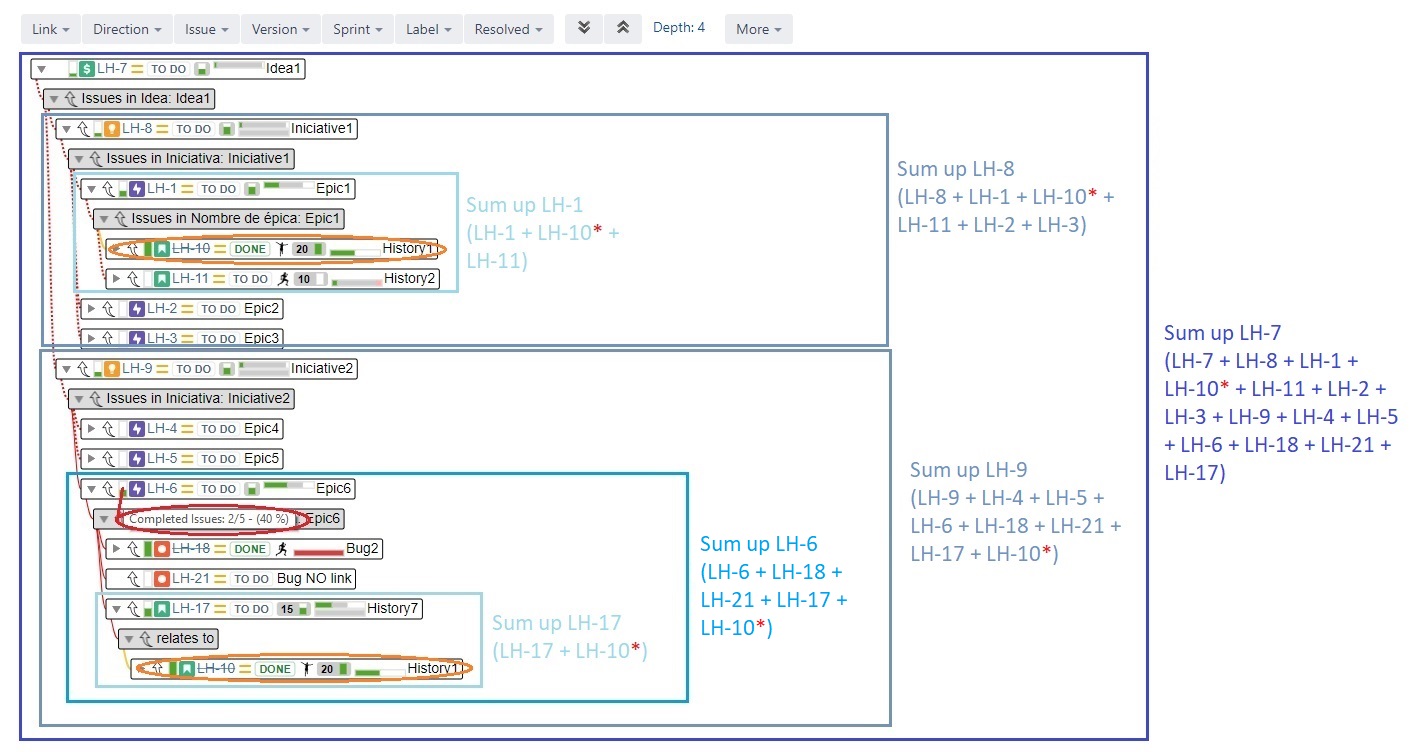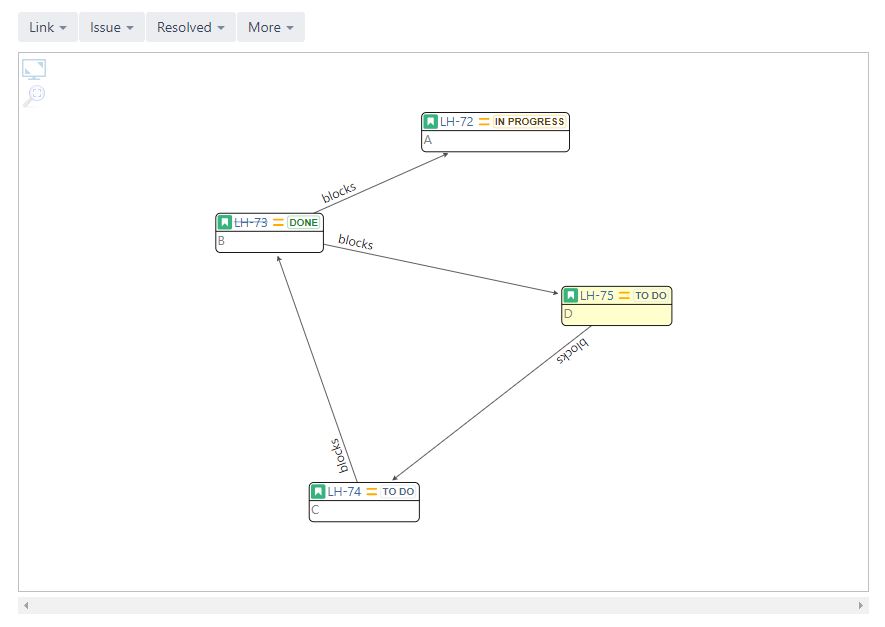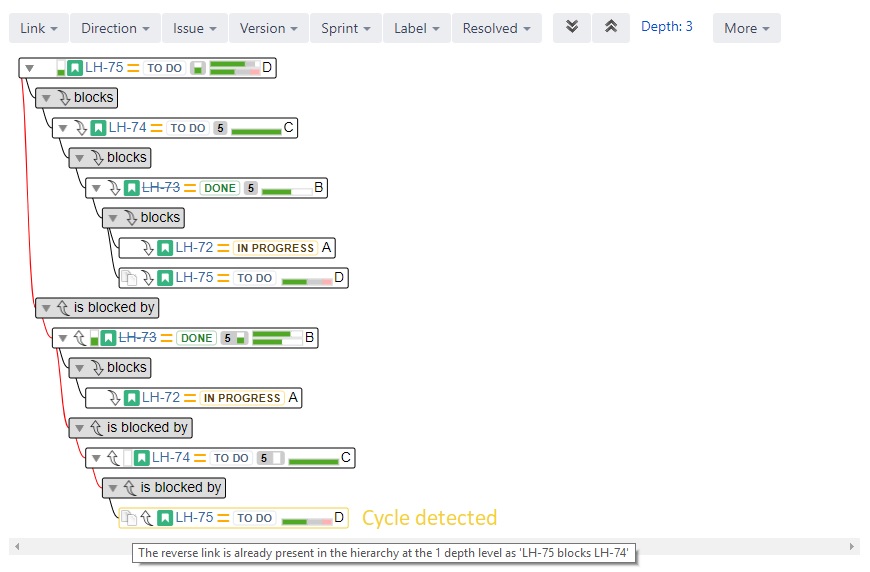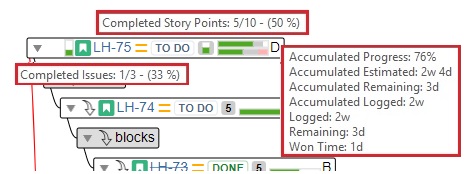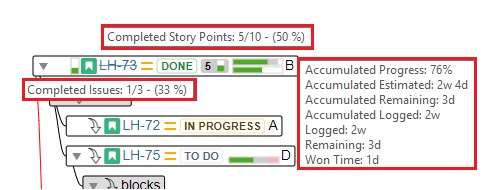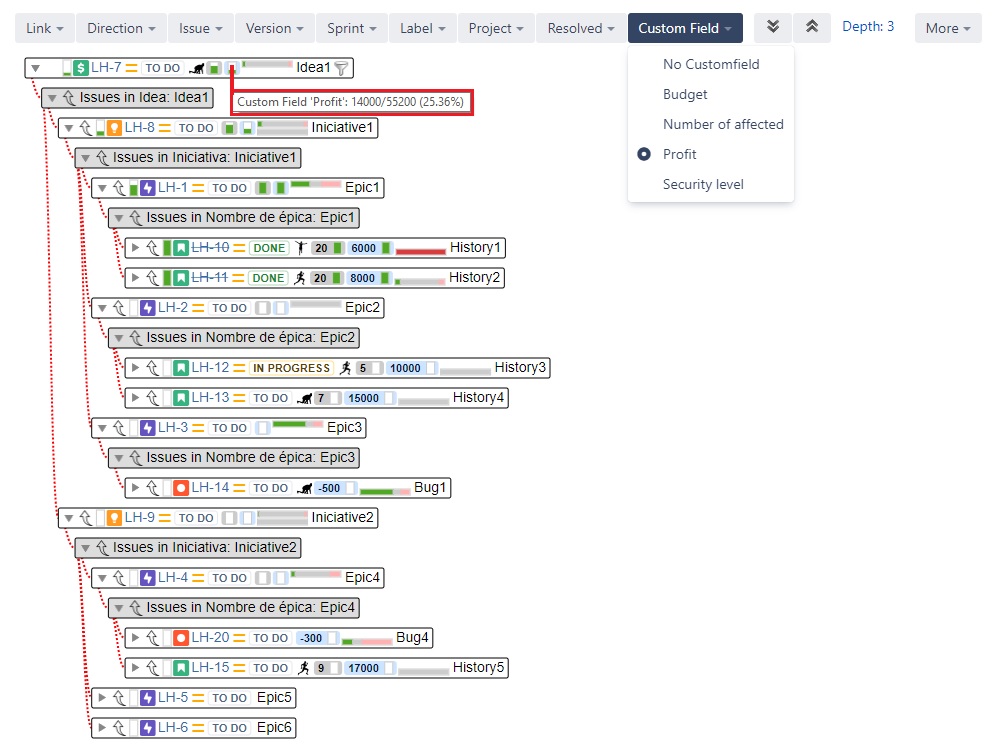Dynamic Progress Roll Up
Links Hierarchy adds new elements that will allow you to know the status of each issue at a stroke.
You will not only know the progress of each individual issue, but you will also be able to know the progress of each issue with respect to the other issues with which it is related. You can know the progress of the Epics, you can know how their blocked issues are affected ... and much more, in an easy and simple way. Only you visualize what you want to see, and Links Hierarchy will do the rest.
Not only Jira Software (Agile) is supported, Portfolio for Jira is also supported. See the progress of your initiatives and any element of your hierarchy.
Links Hierarchy calculates three elements of the hierarchy:
- Progress of resolved issues.
- Progress of the history points resolved.
- Progress roll up.
- Progress of custom fields resolved.
and the individual progress of each issue.
Only "inwards" links
Only the issues that are being visualized that are low inward links contribute to the sum.
Link Color
The colors of the links help you to know what problems are contributing to the sum of the one issue.
| Description | |
|---|---|
| The issue does not contribute to the root issue (there is one outward link at least in the branch connecting the issue with the root which breaks the roll-up progress) | |
| The issue contributes to the root (all the chain of linked issues are inward) and all their contributing children are already loaded in the hierarchy, therefore the total contribution of the branch under the issue is well known | |
The issue contributes to the root from more than one way and each way does it partially with the same amount (balanced) | |
or (depending on the app version) | The issue contributes to the root but not all its children have already be loaded, therefore the real total contribution of the branch is unknown as it might vary when more children are loaded |
or (depending on the app version) | The same that the previous one when the issue contributes from more than one branch |
Progress Bars Colors
You will see different colors in the progress bars.
| Color | Description |
|---|---|
Time spent If it has been worked longer than estimated, it will appear in the tooltip as "Time spent till 'over time estimation'". Otherwise, it will appear as "Logged". | |
| Work time that exceeds the estimated. | |
| Time remaining. | |
| Won time. | |
| Remaining time after the original estimate. |
Individual progress of each issue
Shows the individual progress of the issue. Appears in all issues that have time tracking.
Progress of resolved issues
Show the number of resolved issues in the hierarchy that is being displayed. It appears in the root issue, and in all those issues that contribute to it.
Progress of the history points resolved
Show the number of history points resolved in the hierarchy that is being viewed. It appears in the root issue, and in all those issues that contribute to it.
Progress roll up (on intermediate levels)
"Links Hierarchy" extends its functionality and provides progress roll up in all issues, and not only in the root issue.
Now you can also see the progress of the issues that influence the issue you are visualizing, allowing you to monitor and better analyze progress.
| Old progress roll up vs New progress roll up | |
|---|---|
| Old version | New version |
It shows the progress roll up for the root issue, as well as the issues that contribute to that sum. When an issue appears in several places contributing, it only contributes to the sum in its first appearance. In the image, LH-10 only contributes to the issues that appear along the way (LH-7, LH-8, LH-1). LH-10 did not contribute to the path (LH-7, LH-9, LH-6, LH-17) until all the previous appearances were hidden. | It shows the progress roll up in all the issues that influence the root issue. When an issue appears in several places contributing, it contributes to all its ancestors. In the image, LH-10 contributes to the roads (LH-7, LH-8, LH-1) and (LH-7, LH-9, LH-6, LH-17). This allows you to see the actual progress of each of the issues that contribute to the root. |
| When an issue appears in several places contributing, its first appearance is shown with a red link to indicate that it contributes to the sum. The other appearances are shown with a black link to indicate that they do not contribute to the sum. | When an issue appears in several places contributing, all your appearances are shown with an orange link to indicate that the issue is contributing in different ways. |
Cycle detection
Jira Server only
When creating links between issues, it may happen that you create cycles between the issues. In some cases, these cycles do not have functional logic and cause their analysis of progress is not correct.
Now, "Links Hierarchy" helps you detect those cycles.
For example, suppose we have 4 issues (A, B, C, and D) |
Which issue should be resolved first? How long would it take to resolve issues B, C and D?
A cycle appears that does not have functional logic, so these questions do not have an easy answer.
These cases are detected by "Links Hierarchy", and will mark the issues where it occurs with an orange border. You can review each case and decide if it is correct or not.
Progress roll up on cycles When "Links Hierarchy" detects a cycle, it does not load the descendants indefinitely because it would be an infinite loop. Instead, "Links Hierarchy" warns that the issue was previously shown, and that issue would no longer contribute to the sum. In these cases, you must take into account that being a hierarchical sum, the intermediate issues from the root issue to the issue detected as a cycle, do not contain the total sum of the cycle. That is, the sum in the cycle issues should be: Sum up LH-73 (B) → (LH-73 + LH-74 + LH-75) Sum up LH-74 (C)→ (LH-73 + LH-74 + LH-75) Sum up LH-75 (D) → (LH-73 + LH-74 + LH-75) Being a hierarchical sum, "Links Hierarchy" calculates: Sum up LH-75 → (LH-75 + LH-73 + LH-74) OK Sum up LH-73 → (LH-73 + LH-74) MISSING Sum up LH-74 → (LH-74) MISSING In the cycle issues, the total sums will appear in the root issues: |
Progress of custom fields resolved
"Links Hierarchy" has added functionality to visualize the progress of number custom fields (work in the same way as story points):
<sum of the values of the custom field in the resolved issues> / <sum of the values of the custom field in all the issues of the hierarchy> (percentage that represents the sum of the values of the custom field in the resolved issues on the total sum in the hierarchy)
Where is my custom field?
A custom field will be shown in the menu, if it has value for at least one issue in the hierarchy displayed.
Jira Cloud notes
For reasons of efficiency, existing custom fields in the Jira Cloud instance and global time tracking settings, are read only once. So, if custom fields are created in the Jira Cloud instance (or time tracking settings 'Working hours per day', 'Working days per week' are modified), it will be necessary to clean the filters ("Reset configuration" option) for the app refreshes them.
